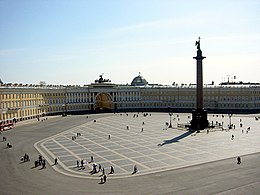
Pushkin is a municipal town in Pushkinsky District of the federal city of St. Petersburg, Russia, located 24 kilometers (15 mi) south from the center of St. Petersburg proper, and its railway station, Tsarskoye Selo, is directly connected by railway to the Vitebsky Rail Terminal of the city. Population: 92,889 (2010 Census).
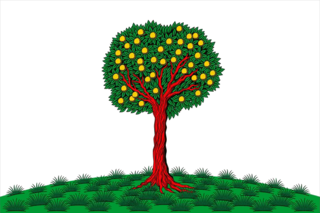
Lomonosov is a municipal town in Petrodvortsovy District of the federal city of Saint Petersburg, Russia, located on the southern coast of the Gulf of Finland, 40 kilometers (25 mi) west of Saint Petersburg proper. Population: 42,505 (2010 Census); 37,776 (2002 Census). Lomonosov is the site of the 18th-century royal Oranienbaum park and palace complex, notable as being the only palace in the vicinity of Saint Petersburg that was not captured by Nazi Germany during World War II.


Kotlin is a Russian island, located near the head of the Gulf of Finland, 32 kilometres (20 mi) west of Saint Petersburg in the Baltic Sea. Kotlin separates the Neva Bay from the rest of the gulf. The fortified city of Kronstadt is located on the island and forms part of a World Heritage Site that is Saint Petersburg and Related Groups of Monuments. The island serves as a gateway to Saint Petersburg and as such has been the site of several military engagements. The Kotlin programming language is named for the island, much as the Java programming language shares its name with an Indonesian island.

Gatchina is a town and the administrative center of Gatchinsky District in Leningrad Oblast, Russia. It lies 45 kilometers (28 mi) south-south-west of St. Petersburg, along the E95 highway which links Saint Petersburg and Pskov. Population: 92,937 (2010 Census); 88,420 (2002 Census); 79,714 (1989 Census).

Pavlovsk is a municipal town in Pushkinsky District in the suburban part of the federal city of St. Petersburg, Russia, located 30 kilometers (19 mi) south from St. Petersburg proper and about 4 kilometers (2.5 mi) southeast from Pushkin. Population: 16,087 (2010 Census). Known since the late 18th century, when Saint Petersburg was the capital of Russian Empire, as a countryside residence of Russian royal family commissioned creation of the town's landmark -palace with a large park, now parts of its federal museum reserve.

The Saint Petersburg Flood Prevention Facility Complex, unofficially the Saint Petersburg Dam, is a 25 km (16 mi) long complex of dams for flood control near Saint Petersburg, Russia. The dam extends from Lomonosov northward to Kotlin Island, then turns east toward Cape Lisiy Nos near Sestroretsk.
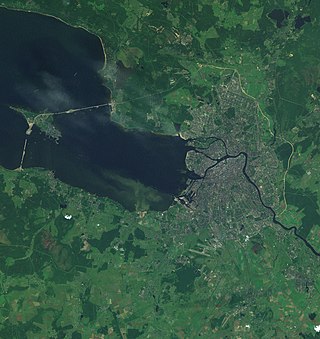
Saint Petersburg is a city and a federal subject located in the Northwestern Federal District of Russia. It stands at the mouth of the Neva River at the east end of the Gulf of Finland.
The appearance of Saint Petersburg includes long, straight boulevards, vast spaces, gardens and parks, decorative wrought-iron fences, monuments and decorative sculptures. The Neva River itself, together with its many canals and their granite embankments and bridges help to give the city its particular ambience.
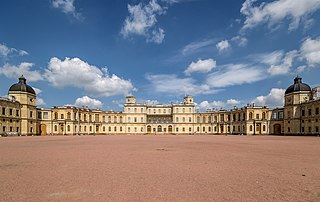
The Great Gatchina Palace is a palace in Gatchina, Leningrad Oblast, Russia. It was built from 1766 to 1781 by Antonio Rinaldi for Count Grigori Grigoryevich Orlov, who was a favourite of Catherine the Great, in Gatchina, a suburb of the royal capital Saint Petersburg. The Gatchina Palace combines classical architecture and themes of a medieval castle with ornate interiors typical of Russian classicism, located on a hill in central Gatchina next to Lake Serebryany. The Gatchina Palace became one of the favourite residences of the Russian Imperial Family, and during the 19th century was an important site of Russian politics. Since the February Revolution in 1917, it has been a museum and public park, and received UNESCO World Heritage Site status in 1990.

Gatchinsky District is an administrative and municipal district (raion), one of the seventeen in Leningrad Oblast, Russia. It is located in the southwestern central part of the oblast and borders with Krasnoselsky, Moskovsky, and Pushkinsky Districts of the federal city of St. Petersburg in the north, Tosnensky District in the east, Luzhsky District in the south, Volosovsky District in the west, and with Lomonosovsky District in the northwest. The area of the district is 2,868.7 square kilometers (1,107.6 sq mi). Its administrative center is the town of Gatchina. Population : 140,210 (2010 Census); 132,010 ; 138,022 (1989 Census).

Saint Petersburg, formerly known as Petrograd (1914–1924) and later Leningrad, is the second-largest city in Russia after Moscow. It is situated on the Neva River, at the head of the Gulf of Finland on the Baltic Sea. The city had a population of roughly 5.6 million residents as of 2021. Saint Petersburg is the fourth-most populous city in Europe, the most populous city on the Baltic Sea, and the world's northernmost city of more than 1 million residents. As Russia's Imperial capital, and a historically strategic port, it is governed as a federal city.

The Peterhof Palace, is a series of palaces and gardens located in Petergof, Saint Petersburg, Russia, commissioned by Peter the Great as a direct response to the Palace of Versailles by Louis XIV of France. Originally intending it in 1709 for country habitation, Peter the Great sought to expand the property as a result of his visit to the French royal court in 1717, inspiring the nickname of "The Russian Versailles". The architect between 1714 and 1728 was Domenico Trezzini, and the style he employed became the foundation for the Petrine Baroque style favored throughout Saint Petersburg. Also in 1714, Jean-Baptiste Alexandre Le Blond, likely chosen due to his previous collaborations with Versailles landscaper André Le Nôtre, designed the gardens. Francesco Bartolomeo Rastrelli completed an expansion from 1747 to 1756 for Elizabeth of Russia. The palace-ensemble along with the city center is recognized as a UNESCO World Heritage Site.

Lomonosovsky District is an administrative and municipal district (raion), one of the seventeen in Leningrad Oblast, Russia. It is located in the west of the oblast and borders with Petrodvortsovy and Krasnoselsky Districts of the Federal city of Saint Petersburg in the east, Gatchinsky District in the southeast, Volosovsky District in the south, Kingiseppsky District in the southwest, and the city of oblast significance of Sosnovy Bor in the west. In the north, the district is bounded by the Gulf of Finland. The area of the district is 1,919 square kilometers (741 sq mi). Its administrative center is the town of Lomonosov. Population: 70,245 (2010 Census); 65,297 ; 66,104 (1989 Census).

Saint Petersburg – second-largest city in Russia. An important Russian port on the Baltic Sea, it has the status of a federal subject. Its name was changed to "Petrograd" in 1914, then to "Leningrad" in 1924, and back to Saint Petersburg in 1991.

Pavlovsk railway station is a railway station located in Pavlovsk, Pushkinsky District of Saint Petersburg, Russia. It is 26 km down-line from Vitebsky railway station and is situated between Tsarskoye Selo and Antropshino on the Saint Petersburg — Vitebsk line. Also it combines route out of Novolisino and Tosno on the Saint Petersburg — Moscow line. The station hosts suburban trains from Saint-Petersburg, Novolisino, Posyolok, Oredezh, Luga and Veliky Novgorod. Electric trains ED4M, ER2T, DT1 and railbus RA2 make a passenger trips from Pavlovsk. Long-distance trains have not stop at Pavlovsk station. The station is approximately 1,4 km from the town center. It has official status as an object of Russian cultural heritage.
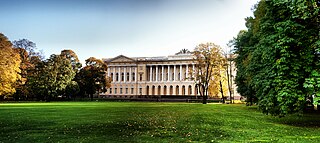
The Mikhailovsky Garden is a large area of parkland and landscape garden in the centre of Saint Petersburg.
